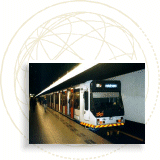home | nieuws | projecten | www-links | bibliotheek | vraag het RCM
| London Underground
History Because of the piecemeal development of the metro system, the Underground is highly diverse in terms of station layouts, means of access, age and condition. The older parts were not designed with crime prevention in mind and contain many inconvenient interchanges, long passageways, and "blind corners". The variety of design, age, and usage makes it harder to find crime prevention measures which can be used on a general basis. |
|||||||
|
|||||||
Source: López, M.J.J., Crime Prevention Guidelines for the Construction & Management of Metro Systems, Den Haag: RCM-advies 1996, pg. 15-18. |

 The London Underground is not only the oldest, it is also one
of the largest metro systems in the world. The first three stations
were built as early as 1863. After that, the system has gradually
expanded. By about 1910, the biggest part of the central area
and inner suburban network were completed. At this moment, the
London Underground covers 9 lines, 271 stations, 436.5 kilometres
of track, and more than 4,000 vehicles. The average ridership
is 2.5 million passengers a day.
The London Underground is not only the oldest, it is also one
of the largest metro systems in the world. The first three stations
were built as early as 1863. After that, the system has gradually
expanded. By about 1910, the biggest part of the central area
and inner suburban network were completed. At this moment, the
London Underground covers 9 lines, 271 stations, 436.5 kilometres
of track, and more than 4,000 vehicles. The average ridership
is 2.5 million passengers a day. Order
this book
Order
this book